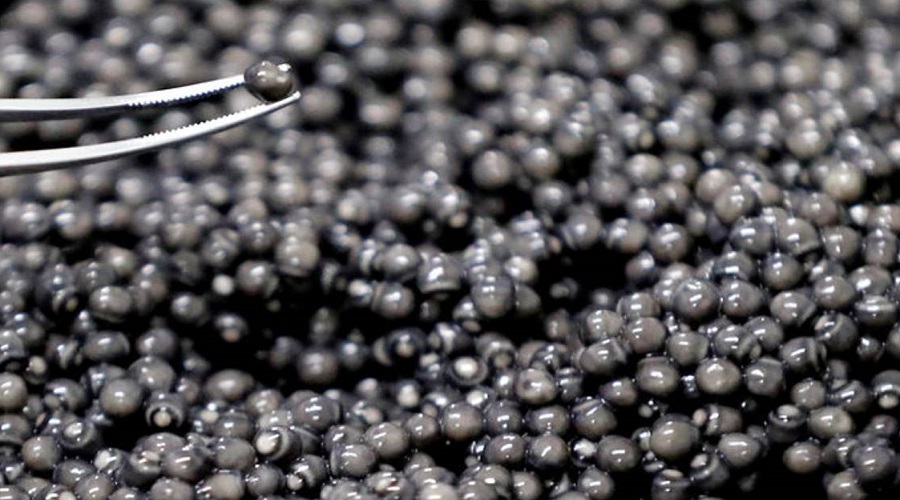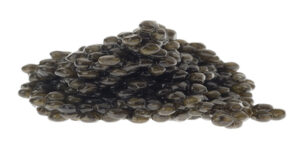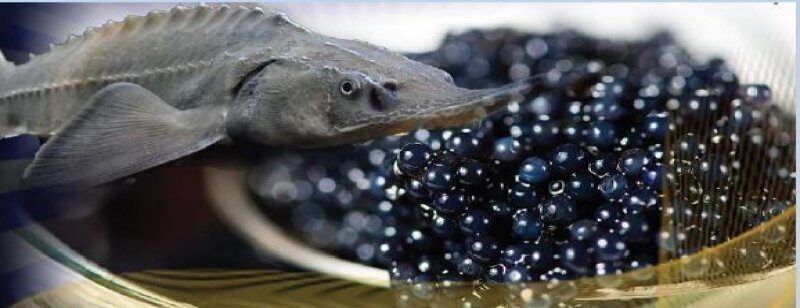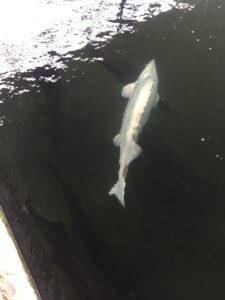Beluga caviar is caviar consisting of the roe (or eggs) of the beluga sturgeon Huso huso. The fish is originally found in the Caspian Sea, the world’s largest salt-water lake, which is bordered by Iran, Azerbaijan, Kazakhstan, Russia, and Turkmenistan. It can also be found in the Black Sea basin and the Adriatic Sea. Beluga caviar is the most expensive type of caviar.
Back to the Category page
About Beluga Caviar
Beluga caviar lays the largest and softest roe of any sturgeon. These glorious shining eggs are considered a luxury commodity, with a price often somewhere between $5000 and $10,000 per kilogram. Caviar connoisseurs consider eating beluga caviar one of life’s greatest pleasures, raving about its impossibly smooth texture and life-enriching taste, so why has beluga caviar specifically become such a prized and expensive food? It’s because of fish itself. The beluga sturgeon is huge, in rare cases even weighing more than 2000lbs and growing over 20 feet in length! It can also live for over 100 years. Consequently, the female beluga sturgeon has a very long maturation cycle, taking around 20 years in nature and around 12 in farm. This means that a caviar farmer has to invest huge amounts of time, money and resources feeding and raising a beluga sturgeon. This, combined with the beluga caviar’s size and extraordinary flavor.
So, as it stands, beluga caviar is illegal in the US through legitimate retailers. Nevertheless, some merchants continue to sell it through black market operations. If you are looking to buy beluga caviar, be sure that it’s done so within the parameters of the laws in your local area.
Harvesting
The Beluga sturgeon currently is critically endangered. In 2006, the Convention on International Trade in Endangered Species (CITES) suspended all trade made with the traditional caviar-producing regions of the Caspian and Black Seas (Beluga, Ossetra and Sevruga), (Azerbaijan, Bulgaria, China, Iran, Kazakhstan, Romania, Russia, Serbia and Montenegro, Turkmenistan, and Ukraine) due to the producing countries’ failure to apply international regulations and recommendations. Caviar from Iran is exempted from the ban. Iran is considered by CITES to practice effective conservation and policing of its fisheries
The beluga sturgeon can take up to 12 years to reach maturity in farm condition. The fish harvested for caviar are often nearly 100 kg. The eggs themselves are the largest of the commonly used roes, and range in color from dark gray (almost black) to light gray, with the lighter colors coming from older fish, and being the most valued.
The most expensive caviar is beluga-albino caviar often called “Almas”. Almas is a golden caviar produced from the eggs of a very rare female albino sturgeon between 60 and 100 years old, which swims in the southern Caspian Sea near Iran where apparently less pollution exists. Very few of the albino variety are left in the wild since the lack of melanin is a genetic disorder that only affects a few members of the species. A kilogram of this almost white “black gold” caviar is regularly sold for £20,000 (USD 25,500). Almas caviar is thought of as one of the most luxurious caviars in the world. Almas is white in color with a smooth texture. It is known to have a distinct nutty and creamy flavor.
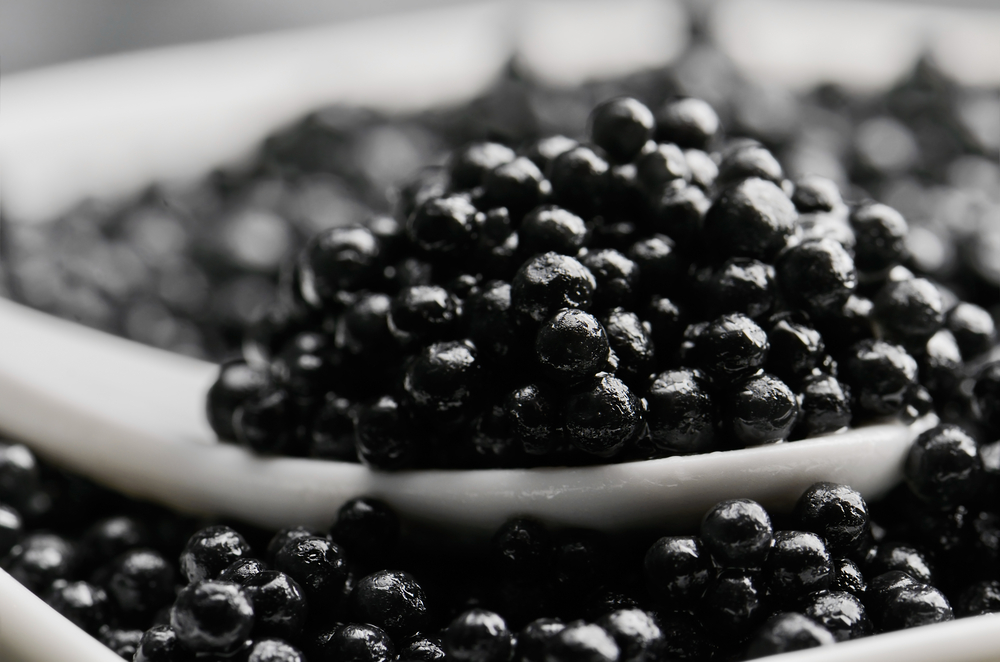
Service
As with most caviars, beluga is usually handled with a caviar spoon made of mother of pearl, bone, or other nonmetallic material, as metal utensils tend to impart an unwelcome metallic taste to the delicate roe. Beluga caviar is usually served by itself on toast, unlike other less expensive caviars that can be served in a variety of ways, including hollowed and cooked new potatoes, on a blini, or garnished with sour cream, crème fraiche, chopped onions, or minced hard-boiled egg whites. These items can, however, be served with beluga as palate cleansers.
History of Caviar
Origins of Caviar
Caviar has enjoyed lasting fame as the luxury treat in the most upscale social circles. So what’s the story behind the mystery and mystique of this luxurious indulgence?
Caviar is basically the roe of the female sturgeon, a large – it can grow to over 1500 kg, but averages 40 kg- migratory fish that has roamed the cold waters of the northern hemisphere for over 250 million years. Sturgeon is found mainly in the Caspian Sea, which laps the shore of the two major caviar-producing countries in the world, Iran and Russia, but is also found in the Black Sea, some parts of the Pacific Northwest and South Atlantic regions of North America, and is common in the big lakes and rivers in Europe. Although it is a saltwater fish, it lays eggs in freshwater.
However, it was the Persians who first prepared and savored sturgeon roe- the word “caviar” actually comes from the Persian word “khav-yar”, because the people of Persia attributed many medicinal powers to caviar. The Persians collected the fish eggs on the Kura River.
The first known record of caviar dates back to the Greek scholar Aristotle. In the 4th Century B.C. Aristotle described this delicacy as the eggs of the sturgeon, heralded into banquets amongst trumpets and flowers. But it was Russia and the Russian Tsars that catapulted caviar into the world of utter luxury. The golden roe of the Sterlet sturgeon – now over fished to the point of near extinction- produced what would become the “imperial” caviar, the most delicate and coveted type of caviar available. As time progressed, caviar spread to all countries across Europe, and was prized by nearly every culture. One jar of caviar equaled one hundred sheep in the second century B.C., making it exclusive to higher-class citizens.
How to Make Caviar
As luxurious and coveted as caviar is, it does seem easy to make, maybe you think it’s just needed some fish eggs and some salt. But it is not the whole thing, While the ingredients might be simple, the methods of making caviar are not. Much like aging a fine cheese or selecting the best grapes for wine, there’s an art to making caviar that goes beyond tossing a little salt on some fish eggs.
The birth of caviar – almost literally- begins with the removal of the fish eggs (roe) from the sturgeon. One of the many reasons sturgeon populations have been in such sharp decline is because the most predominant method of extracting the eggs from the sturgeon involves the actual killing of the fish (either before or after the removal of the egg sack). The roe is sieved and “filtered” into different sizes, and then carefully cleaned and rinsed. Classification takes place according to size and color and the caviar moves on to the salting step.
The purpose of salting is primarily to preserve the caviar, and keep as much of the ‘fresh’ flavor as possible. Therefore, the amount of salt used can vary. types of caviar can be more or less salted. A special kind of salt was – and is- used to prepare caviar.
The first step to making caviar is fishing or harvesting a female sturgeon ripe with eggs, Caviar is made from the unfertilized eggs of the female sturgeon. The sturgeon is fished, opened, and the eggs are manually removed, cleaned and separated. And here’s where the caviar master’s skill comes into play, as he or she carefully removes the membrane surrounding the eggs and separates them, gently and expertly, so the caviar’s texture is preserved, and the eggs aren’t crushed. The delicate eggs are then carefully strained, and salted.
Salting preserves the caviar, extending its shelf life, but it also gives it a wonderful flavor. Salting caviar is a skill acquired over time: too much salt and the delicate walls of the eggs break, too little of it and the caviar will spoil and the taste will be off.
After salting, the caviar is dried and then tested so it can be graded the texture, color, glossiness, size and many other factors are considered, which will determine the quality of the caviar and grade it will get. This is the final step before it is packaged in tins packed tightly with airtight lids, and then sent to be sold.
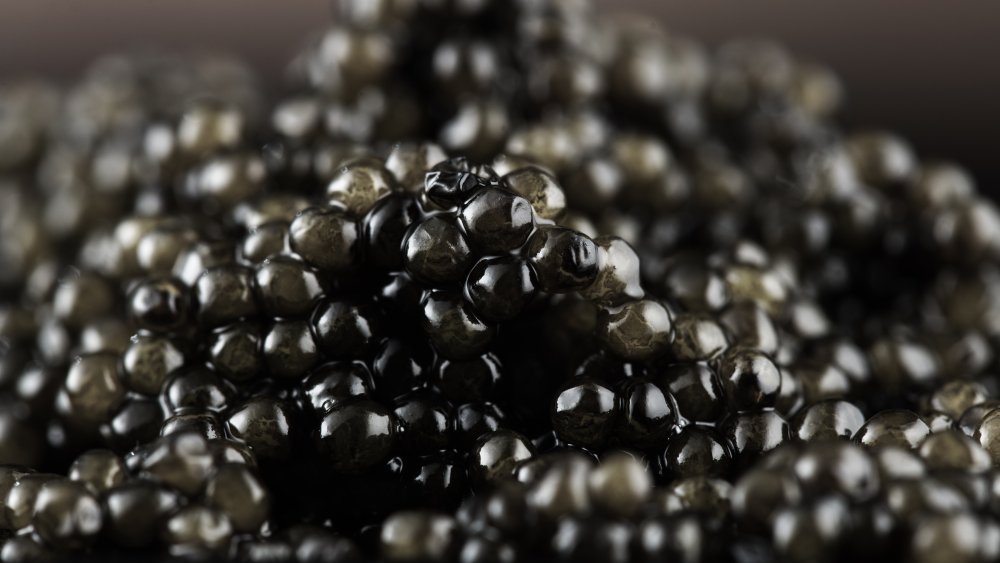
Types of Caviar: Traditional Sturgeon Caviars
Beluga caviar
The most luxurious and high price caviar in the world, Beluga caviar from the huso huso sturgeon is the epitome of culinary sophistication. With large, pearlescent eggs, of a light glistening grey, Beluga is prized for its smooth, buttery texture, and a rich and subtle flavor that melts in the mouth.
Osetra Caviar
It’s not Beluga, but this is truly the next best thing and of course with high price and specific color and taste in the market. Of the higher-end caviars, golden Osetra is a strong contender for the title of ‘best caviar in the world’. Osetra Caviar varies in color from golden to brown, firm grains of medium size and a nutty and rich flavor.
Sevruga Caviar
Of all the sturgeon species, the Sevruga from the Acipenser stellatus sturgeon, reproduces the quickest, and therefore is much more available, which translates into lower market prices for this delicious caviar. You’ll find that these small and delicate grey to black eggs are a pleasure to bite into, with a crunchy texture. While other caviars dissolve in your mouth, Sevruga playfully crackles and pops with a more intense flavor.
Sterlet Caviar
Sometimes confused or mislabeled as Sevruga, this smallish caviar comes from Sterlet sturgeon, Acipenser ruthenus. Sterlet caviar is light to dark grey, with small grains that have an intense flavor.
Kaluga Caviar
Known as river beluga, Kaluga, from the huso Daricus, comes from the Amur River basin, and like most sturgeon caviars these days it is mostly farm-raised, which allows for sustainability and strict quality controls. Kaluga caviar is incredibly similar to Beluga – creamy, smooth, with an almost buttery texture and a great firm pop, and is today one of the tops of the line caviars in the market. Combining all the wonderful characteristics of Beluga caviar, you can eat luxurious Kaluga caviar knowing you are consuming eco-friendly, sustainable caviar of the highest quality.
Many a restaurateur will tell you this is worthy substitute for the pricier sturgeon caviars, especially the pricey Sevruga. Paddlefish comes from the American Spoonbill sturgeon, Polyodon spathula, a fish found in lakes and rivers in the South of the United States. Paddlefish looks very much like Sevruga caviar, with eggs that are small and blackish-grey, and a crisp and light flavor.
Hackleback Caviar
This is another contender when looking to substitute the classic Caspian sturgeon.
Hackleback comes from the American Shovelnose sturgeon, a fish found in Mississippi River. Similar to the Sevruga caviar both in the size and texture of its eggs, Hackleback has small firm eggs that are a dark brown to black. Hackleback sturgeon has the smooth and delicate flavor of a Caspian sturgeon caviar, but milder and with a little extra nutty punch.
Types of Caviar: Other Caviars & Roes
Salmon Caviar (Salmon Roe)
Of course, you shouldn’t name it caviar as it specifically named for sturgeon roe, this roe is worth getting for looks alone. Eggs of a beautiful peach color glisten and sparkle as you place them over some fresh blini or sprinkle them over dishes as a garnish. Widely available in the cold waters of Alaska and Russia, the prices of salmon caviar are dramatically lower than those of sturgeon. The flavor is very fresh, succulent and superbly juicy.
Sushi Caviars or Flying Fish Roe: Capelin, Tobiko and Masago Caviar
These tiny and colorful roes come from different small flying fish from Iceland. The small fish eggs are naturally black, but are dyed and flavored with a variety of ingredients to make them more intense. They’re typically found topping sushi and nigiri dishes. This is not caviar to eat by itself, but rather to use as a garnish.
How to Store Caviar
Caviar is highly perishable and delicate, not to mention pricey, so this delicacy should be handled with the utmost care and respect. Read all labels carefully once you get your product.
Keep refrigerated at about -2°C -+4°C. If you’re keeping it out to serve, and it’s not going to be consumed immediately, keep it in the original jar or tin, over a bowl full of crushed ice. Take caviar out of the refrigerator 10-15 minutes before serving. Fresh caviar can be kept unopened in the refrigerator for four weeks. Once opened, eat caviar within 2-3 days.
WHAT DOES CAVIAR TASTE LIKE?
Connoisseurs love their caviar, but there are many foodies that blanch at the idea of eating caviar. And while it’s normal to balk at the idea – it IS fish eggs, after all – caviar tastes nothing like what one would imagine fish eggs to taste like. Caviar taste is simple – delicious! – but it’s also complicated.
While caviar comes from a fish, it shouldn’t be super fishy. It will always have a mild fishiness and slight saltiness, but the taste of caviar is more like ocean water, rather than in-your-face fish. This of course depends on the quality of the caviar, but good caviar is mild and fresh, with no pronounced intensity, and rather a buttery richness that is wholly unexpected. If it’s very fishy and very salty, then it’s not great quality.
Great caviar has a wonderful texture. The beads roll in your tongue and slide through the roof of your mouth, firm, each bead distinct from the next, with little to no mushiness. Caviar is smooth but has no overwhelming oiliness to it and it has a wonderful pop once you bite into the eggs, releasing a burst of flavor.
The best caviars, like Osetra and Sevruga caviar, are often described as buttery with nutty flavors. However, the flavor profile will vary greatly from tin to tin. Factors that can influence caviar flavor are the species of the sturgeon, where it comes from, the quality of the water where it swims, the food it eats, and even its age – older, more mature sturgeon produce the best caviar.
CAVIAR NUTRITION
Caviar is a rich, calorie-dense food that’s a good source of protein, Vitamins A, B12, B6, C and D. It’s also rich in Magnesium and Iron, Selenium and Calcium, with a good amount of amino acids like lysine, isoleucine, and methionine plus loads of anti-inflammatory Omega-3 thrown in for good measure.
So, if it sounds like caviar is good for you, it’s because it is! Of course, there are cons with all these pros, and the caveat to the wonderful nutritional properties of caviar is that it’s also very high in cholesterol and sodium, so there can be too much of a good thing and you should limit portions.
